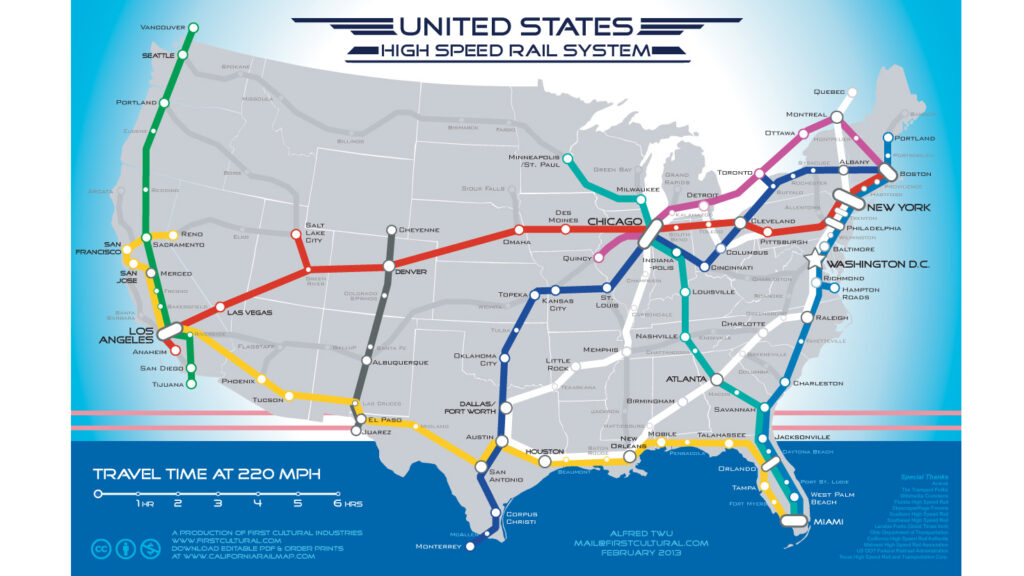The US Journey Towards High-Speed Rail Development
As the United States grapples with its transportation landscape, it faces a stark reality: despite being home to 340 million residents and a vast network of interstate highways and public airports, the nation currently lacks high-speed rail (HSR) systems. However, with two major projects underway, the question arises: Is the US finally moving toward establishing high-speed rail comparable to the networks in countries like China, Japan, and various European nations?
Current Projects on the Horizon
Rick Harnish, head of the High Speed Rail Alliance, has expressed optimism over the initiation of two HSR projects. “The first is the San Francisco to Los Angeles route,” he says. “This is a challenging endeavor due to California’s mountainous terrain.” The second line, connecting Las Vegas to Los Angeles, presents fewer geographic hurdles as it traverses flatter land.
Additional plans include a line stretching from Portland, Oregon, to Seattle, Washington, and further onto Vancouver, Canada. A corridor between Dallas and Houston is also in the works. Nonetheless, Harnish cautions that progress on these projects, particularly the Portland-Seattle line, is sluggish. The Dallas-Houston connection now faces uncertainty following the cancellation of a federal grant by the Trump administration, totaling $63.9 million.
Global Comparisons
The United States, however, still lags significantly behind in high-speed rail development. This year, China’s HSR network is projected to exceed 50,000 kilometers (approximately 31,000 miles), while the European Union boasts 8,556 kilometers of HSR lines, with Spain leading at 3,190 kilometers. In the UK, the only operational HSR line connects the Channel Tunnel to London St Pancras, while High Speed 2 is under construction despite funding challenges.
The International Union of Railways defines high-speed trains as those capable of exceeding speeds of 250 kilometers per hour (155 mph). The US, by contrast, remains entrenched in car culture; many citizens are skeptical about the necessity or desirability of HSR. Journalist and author Will Doig emphasizes this disconnect, noting that government reluctance to fund rail investments exacerbates the nation’s lag behind Europe and Asia.
Obstacles Ahead
The future of high-speed rail in the US faces further complications following the resignation of Amtrak’s CEO, Stephen Gardner, under reported pressure from the White House. Currently, Amtrak operates no high-speed trains, although it plans to introduce 28 new Acela trains on the Northeast Corridor next year. Despite this upgrade, only 50 miles of its 457-mile stretch supports speeds over 150 mph.
| Country | HSR Network Length (km) | Current Projects |
|---|---|---|
| US | 0 | California, Texas |
| China | >50,000 | Ongoing |
| EU | 8,556 | Expansion Plans |
Despite these challenges, Harnish’s organization strives to facilitate the establishment of high-speed rail across the US. “To operate HSR safely, challenges like avoiding highway crossings and ensuring straight, sealed corridors must be addressed,” he warns.
Future Perspectives
Globally, HSR brings economic benefits; for instance, Chinese cities linked by HSR experience an economic boost of about 14.2%, according to research from a Danish think tank. As China expands its influence by aiding other countries in developing their rail networks, concerns grow about potential dependencies on Chinese loans. Will Doig, an advocate for US rail development, expresses hope for collaboration with China in constructing HSR systems, yet acknowledges the political complexities involved.
Ultimately, if the US is to realize an effective high-speed rail network, a shift in public mindset towards embracing public transportation is essential. Harnish highlights the necessity of federal government involvement, especially given the recent withdrawal of federal grants for critical projects.

